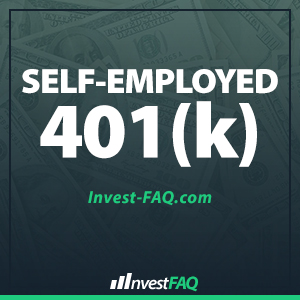 A Solo 401(k) plan (also known as a One-Participant 401(k) plan) provides a great tax break to the smallest business owners by allowing them to shelter from taxes a large portion of income. This article describes the provisions of the US tax code for the 401(k) plan for Self-Employed People, also called the Solo 401(k). These plans were established by the Economic Growth and Tax Relief Reconciliation Act of 2001. The key features of the Solo 401K plan are:
A Solo 401(k) plan (also known as a One-Participant 401(k) plan) provides a great tax break to the smallest business owners by allowing them to shelter from taxes a large portion of income. This article describes the provisions of the US tax code for the 401(k) plan for Self-Employed People, also called the Solo 401(k). These plans were established by the Economic Growth and Tax Relief Reconciliation Act of 2001. The key features of the Solo 401K plan are:
- Contributions can be made from pre-tax or post-tax dollars.
- Contribution limits are much higher than Keogh or SEP plans.
- Assets can be rolled to a Solo 401K from IRAs or other qualified retirement plans.
- The plan may allow loans from the Solo 401K account.
Eligibility
Contents
The Solo 401(k) plan is designed for the small-business owner with no employees. Co-owners of the business and their spouses that work in the business can also participate in the plan. It doesn’t matter if the business is part-time or full-time or was started last week or several years ago. Any business owner, an independent contractor with 1099 income, freelancer, sole proprietor, or in a partnership, Limited Liability Company (LLC) or corporation, can enjoy the full benefits of the Self-Employed 401K.
Contributions
Contributions can made as after-tax Roth contributions (i.e., tax once and done), as before-tax contributions (i.e., tax-deferred), or as a combination of the two. The Roth contributions grow tax-free; neither the principal nor the growth is taxed when cashed out at retirement. The traditional before-tax contributions are tax-deductible upfront and grow tax-deferred, but tax is imposed on both the principal and earnings when withdrawn.
The maximum contribution limits depend on how the business is established, with an overriding limit that changes annually. In tax year 2019, a sole proprietor may contribute up to a total of $56,000 ($62,000 if age 50 or older). In future years the maximum contribution will be adjusted for inflation.
- For businesses that are not incorporated, such as a sole proprietorship, the salary-deferral contribution and the profit-sharing contribution are based on net earned income. In 2019, the salary-deferral contribution is limited to 100% of the first $19,000 of self-employment income (25,000 if age 50+). The profit-sharing contribution is limited to 20% of the self-employment income, as capped by the maximum limit mentioned above. Contributions are not subject to federal income tax, but remain subject to self-employment taxes (SECA). The owner receives a tax deduction for both salary deferral and employer contributions on IRS Form 1040 at filing time.
- For businesses that are incorporated, the contribution limit is also computed from salary deferral and profit sharing numbers, only with a different limit on profit sharing. In 2019, the salary-deferral contribution is limited to 100% of the first $19,000 of corporation W-2 income (26,000 if age 50+). The profit-sharing contribution is limited to 25% of the corporation W-2 income, as capped by the maximum limit mentioned above. It is not subject to federal income tax or Social Security (FICA) taxes. The salary deferral contributions are withheld from your pay and are excluded from federal income tax but are subject to FICA. The business receives a tax deduction for its matching contributions.
Loans
Small-business owners can take a tax-free loan from a Solo 401(k) plan if the plan allows it. The loan amount is limited to the lesser of 50% or $50,000 of the account balance.
You may know already that taking money out of a retirement account before age 59 is a costly move. A loan from a 401(k) is not treated as a distribution if the loan is paid back on time according to the IRS rules. However, if the loan is not paid back according to rules, the loan will be classified as a distribution, which means regular income tax plus a possible 10% early-withdrawal penalty will be payable on the entire loan amount. Funds can be rolled over from a 401(k) with a previous employer or an IRA into a Solo 401(k), and owners can borrow from the plan usually within a couple of weeks after the rollover. But not all 401(k) plans offer the loan feature. Ask your 401(k) provider if their plan allows for participant loans.
Plan Costs
Fees for establishing and maintaining the Solo-401(k) type accounts vary by plan provider and administrator. The plan providers are mostly mutual fund companies with load funds. The plan fees are also a function of the features of the Solo-401(k). Plans that allow assets other than mutual funds in the plan tend to be more costly. On average, the cost to set up and maintain a Solo-401(k) is modest for a 401(k) plan; fees on various plans range from $0 to $200 per year.
Establish by December 31
Each Solo 401K must be set up no later than December 31 of the calendar year to be eligible for tax deductions in that tax year. Small business owners should ask their accountants about this plan and how it may benefit them.
Please visit Daniel Lamaute’s web site for guidance on establishing a Solo 401(k) plan. His company offers a Solo-401(k) plan that includes the loan feature and offers mutual funds by Pioneer Investments.
Article Credits:
Contributed-By: Daniel Lamaute, Chris Lott
